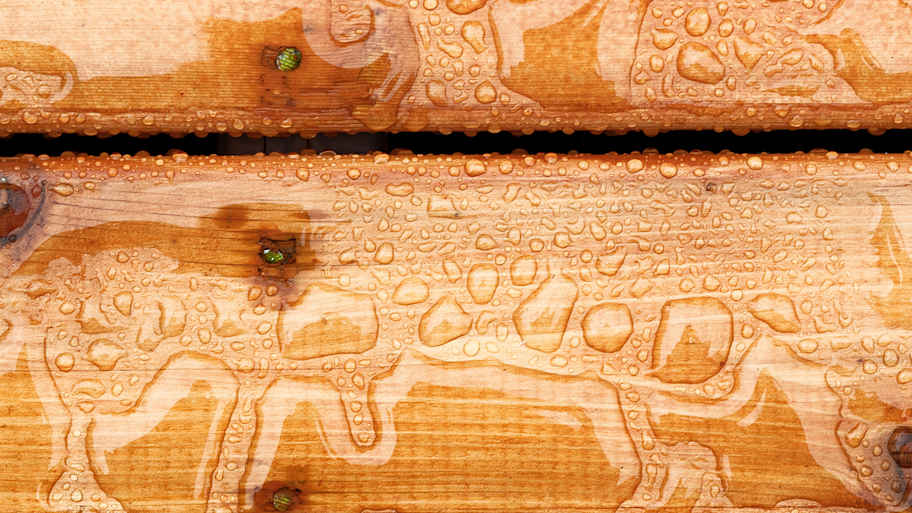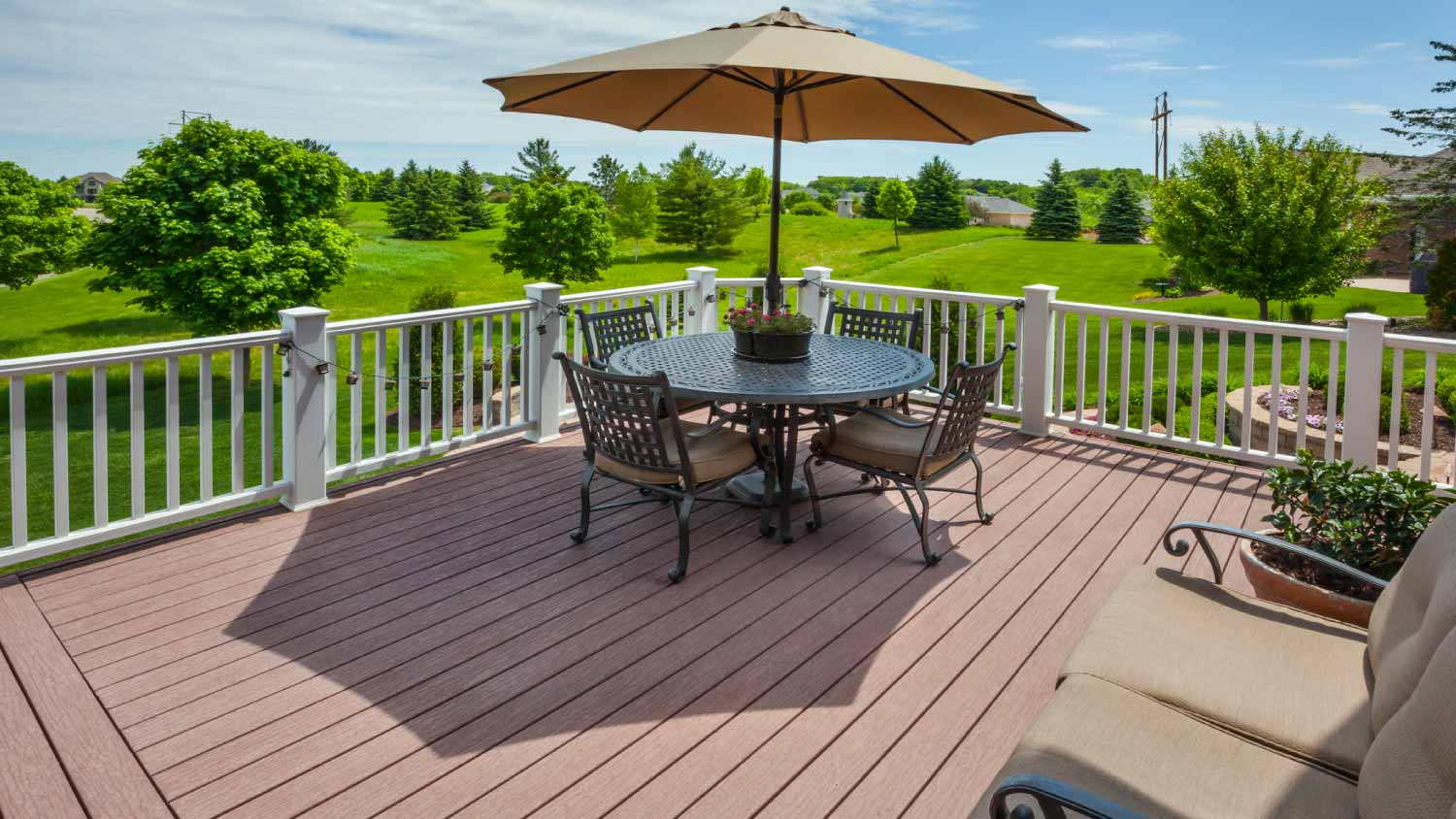
If you’re updating a deck or staircase with a modern railing, you may be wondering how much cable railing costs. We dive into the cost factors you need to know.
Your deck is not molting on purpose


Not prepping your wood deck for staining properly often results in peeling.
Ensuring you use the correct stain for your deck’s wood type is key to success.
Weather conditions can impact whether your deck stain sticks or ends up peeling.
Hiring a pro to stain your deck is one of the best ways to ensure it won’t peel.
Homeowners can expect to pay an average of $850 for professional deck staining.
Peeling deck stain is an epic eyesore and often a sign that something went wrong during application. Thankfully, there are steps you can take to prevent it from happening. Here's a look at what causes deck stain to peel and what to do if it’s already begun.

One of the biggest culprits behind deck stain peeling is a mistake many homeowners make: applying stain to a surface that has not been adequately cleaned, sanded, or allowed to dry. When that happens, dirt, mildew, and moisture get trapped under the stain, preventing proper adhesion, which causes the finish to bubble or flake off prematurely.
One of the best ways to prevent this issue is to work with a professional deck staining company. Homeowners can expect deck staining to cost an average of $850, depending on the size of their space and labor costs in their area.
Clean the surface thoroughly with a deck cleaner or wood brightener to remove dirt, grime, and old finishes.
Treat mold or mildew using an oxygenated bleach solution, not chlorine bleach, which damages wood.
Let the deck dry completely for at least 24 to 48 hours after washing.
Lightly sand any rough, splintered, or fuzzy areas to smooth the surface and help the wood better absorb the stain.
Check the wood's moisture content using a meter and ensure it reads below 19% before staining.
Apply the stain evenly with a sprayer, roller, or brush, working with the grain and in manageable sections.
Allow your deck stain to dry and cure fully for 72 hours or per the manufacturer’s instructions.
Not all stains are created equal. Using the wrong stain formula for your wood type or reapplying a film-forming stain over a penetrating one, or vice versa, can lead to poor bonding and eventual peeling. Look for stains that are appropriate for your climate, too—not all products offer the same level of UV protection.
Know your wood type; for example, softwoods, like cedar or pine, do better with semi-transparent stains.
If reapplying over an old stain, use a compatible formula and test a small area first.
Strip off incompatible or layered finishes before restaining.
Choose penetrating stains for better long-term performance, especially in high-traffic areas.
Avoid solid stains on horizontal surfaces in a wet climate because they tend to peel more than semi-transparent types.
Think like Goldilocks: if it is too hot, cold, or humid, your stain may not cure properly, leading to adhesion problems. Rain shortly after application can also wash away or blister the stain. Remember, it is always best to refer to the manufacturer's instructions when in doubt.
Apply stain when temps are between 50°F and 80°F.
Skip staining in direct sunlight; it causes the stain to dry too quickly, impacting penetration.
Avoid staining if the weather report predicts rain in your area within 72 hours of application.
Check humidity levels to ensure they are within 40% to 70% before staining.
Stain early or late in the day to avoid the midday heat if working in summer or under extreme weather conditions.

More is not always better. Applying too thick a coat or adding multiple coats when not recommended can cause the stain to sit on the surface rather than soak in, leading to cracking, flaking, and peeling.
Follow the manufacturer's guidelines for application thickness and number of coats.
Use a brush or pad applicator to work the stain into the wood grain.
Wipe off any excess stain using a clean, dry cloth after a few minutes to prevent buildup.
Let each coat of stain dry completely before applying another if multiple coats are allowed.
Use a paint tray or bucket, roller, brush, or sprayer to avoid pouring the stain directly and unevenly.
Look for these early warning signs before things get worse:
Flaking, chipping, or bubbling
Patches where the stain appears thin or missing
Discoloration or gray wood showing through
Sticky or tacky areas that never thoroughly dried
Uneven or blotchy surface
Finish comes off when scrubbed or touched
If you’ve cleaned, sanded, and reapplied stain more than once and it’s still peeling, it might be time to call in a pro. Persistent peeling often points to underlying issues like moisture trapped in the wood, poor ventilation, or the wrong type of product for your deck’s condition. A professional deck builder near you can assess whether your wood is compatible with stain or if switching to a different finish makes more sense. Sometimes, a deck pro may weigh in on paint versus stain for decks, especially if your deck has aged significantly or has already been coated multiple times. Paint can offer longer-lasting protection for weather-beaten surfaces, even if it hides some of the wood’s natural beauty.
From average costs to expert advice, get all the answers you need to get your job done.

If you’re updating a deck or staircase with a modern railing, you may be wondering how much cable railing costs. We dive into the cost factors you need to know.

Cedar is a popular decking material, best known for its natural wooden look and resistance to rot. So, how much does a cedar deck cost? Find out in this guide.
Deck repair costs depend on materials, damage you need to fix, and more. See how much it costs to replace or repair a deck in Columbus, OH.

The cost of expanding your outdoor space with an elevated deck depends on the project size and the materials used. Plan your project budget with this guide.

Are you wondering if a porch or deck is better for your home? Compare the pros and cons of these two outdoor favorites to help you find your best fit.

Not sure what deck size you need? Learn about standard deck sizes and what factors to consider to get the right dimensions for backyard bliss.